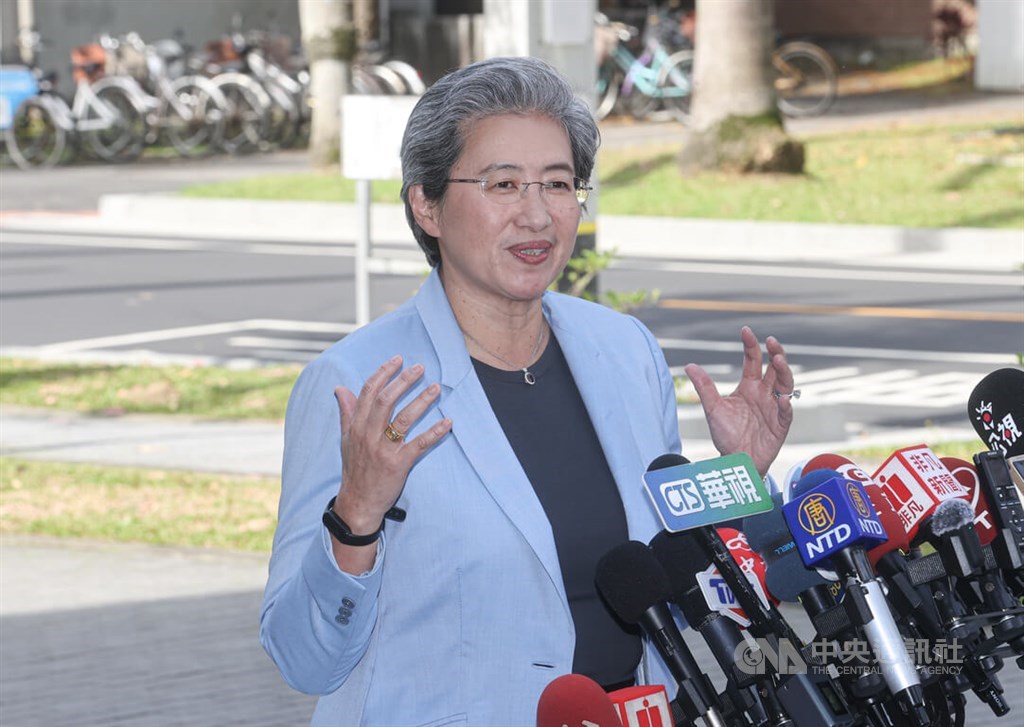Taipei, April 15 (CNA) Taiwan’s role in the evolving landscape of artificial intelligence (AI) is “very special” and its manufacturing ecosystem is heavily relied on by the United States, AMD Chair and CEO Lisa Su (蘇姿丰) said Tuesday at National Taiwan University (NTU).
Speaking in a chat with NTU President Chen Wen-chang (陳文章) titled “AMD’s Transformation to AI Leader,” Su, the first speaker of this year’s NTU’s Royal Palm Lecture Series, praised the ecosystem surrounding AI in Taiwan.
It all starts with the ecosystem of Taiwan Semiconductor Manufacturing Co. (TSMC), and then includes “the ODM, OEM ecosystem, manufacturing ecosystem, [and] design ecosystem,” said Su, who also answered questions from students.
She said that such an ecosystem leads her to believe that more investment on the software and system side will come into Taiwan in the future.
“From a U.S. standpoint, I think we do rely on a lot of the Taiwan manufacturing ecosystem, and trying to build resilience into that ecosystem is important,” said Su, who was born in Tainan and immigrated to the United States with her parents at the age of 3.
In addition, Su noted that Advanced Micro Devices, Inc. (AMD) has teams based in Taiwan, which have been a “very important piece” of the U.S.-based company’s overall research and development efforts.
Before the lecture, Su told reporters that she had met TSMC Chairman C.C. Wei (魏哲家) on Monday, with plans to meet AMD’s customers and supply chain partners in Taiwan on Tuesday and Wednesday.
“As always, the Taiwan ecosystem is so important to us,” she said.
For many tech companies, however, U.S. President Donald Trump’s on-again, off-again tariffs have complicated their plans and how they will set up their manufacturing supply chains or work with Taiwanese partners.
When asked about the tariffs and their impact on the supply chain, Su did not go into much detail, saying only that it was a “dynamic situation” but that she believed “we can work very closely with our partners to manage any of the supply chain issues.”
On AI, DeepSeek, Nvidia
The Taiwan ecosystem Su described has been instrumental in making the components designed by fabless companies like AMD and Nvidia Corp. and is critical in powering tools such as ChatGPT.
When the discussion turned to DeepSeek, a large language model introduced by a Chinese team in early 2025, Su said it could not be underestimated.
“When you look at what they’ve done, it’s actually pretty clever technology in terms of really gathering all of the different innovations using the mixture of expert models,” she said.
“But the main thing that we saw with DeepSeek is when you can find a way to make AI more accessible and actually cheaper, you actually will have more usage and application of AI” she said, adding that the release of DeepSeek “really has accelerated” AI applications.
She stressed, however, that there is no “one-size-fits-all” AI computing ecosystem.
“You have the very large frontier models… You also see there will be many different medium-sized models, smaller models,” Su said, noting that those using the latter “will use different algorithms to get there.”
Su said she expected investment in AI to remain significant, encompassing both large-scale funding and more affordable approaches going forward.
Asked by Chen how AMD plans to compete with Nvidia, a company founded and led by Su’s distant relative Jensen Huang (黃仁勳) that dominates the AI chip market, Su did not directly answer the question but emphasized AMD’s broader strategy.
“The market is huge… you need every kind of computing. You need CPUs, GPUs, you need ASICs, you need FPGAs,” she said, noting that AMD’s number one AI strategy is to “have a very complete solution,” which includes hardware, software and systems.
“The second piece is to have an open ecosystem,” she said, explaining that it helps foster collaboration by enabling people to learn from each other.
A strategic turn
Asked about AMD’s transformation over the past decade — from a company best known for CPUs to one expanding into GPUs and adaptive computing, both essential to AI development — Su discussed the changes by highlighting the company’s strategic focus since she became CEO in 2014.
“Probably the most important thing with any company is to decide what do you want to be when you grow up?” Su said. “For AMD, my belief is that our specialty is in high-performance computing (HPC).”
For a technology company, “the most important thing is you have to have a long-term strategy and roadmap,” Su said, while describing HPC — the use of supercomputers or computer clusters to solve complex problems requiring massive computation — as one of AMD’s three core focuses.
The other two, she said, are “excellent partnerships” and the recognition that “the semiconductor industry is changing.”
Su said she was “very happy” to share that five out of the top 10 supercomputers are currently based on AMD’s technology.
“From that standpoint, I really feel that HPC is at the center of what’s most important going forward,” she said.
